Rockwell Video Minute: Portraits of Presidents
Norman Rockwell spent his share of time in Washington, D.C. painting presidents and presidential candidates. He said, “I am no politician and certainly no statesman. But I have painted thousands of people and I should by now be a judge of what their faces say about what they are.”
See all of the videos in our Rockwell Video Minute series at saturdayeveningpost.com/category/rockwell-video-minute/.
Rockwell Video Minute: Rockwell’s Love of Modern Art
Norman Rockwell’s The Connoisseur is a playful look at his take on modern art.
See all of the videos in our Rockwell Video Minute series at saturdayeveningpost.com/category/rockwell-video-minute/.
Rockwell Files: The Pirate in Rockwell’s Family Tree
According to Rockwell, this cover took him longer to paint than any other. The reason was that pirate at the root of the family tree.
In 1959, Rockwell was dictating his autobiography to son Tom and thinking back over his family history. It might have been what inspired him to paint the family tree of an all-American boy.
The shape was based on a 12th-century Dutch family tree. He indicated the bloodline by the heads that touch the branches.
You’ll notice a family resemblance among most of the men; they were all created from the same model. However, the face of the austere New England minister is Rockwell’s own.
He struggled with this painting for months. It was hard work to make each face convey a character. What’s more, he had to decide whom to put at the base of the tree. Would it be royalty or rabble? Both, he decided, and he began with a pirate and a princess seized from the Spanish galleon shown in the lower corner. But when a friend saw this, he asked Rockwell, “Do you think you ought to start off the family with him, a cutthroat, a barbarian?”
Rockwell reconsidered. He replaced the pirate with a Puritan. Unhappy with that, he replaced him with a buccaneer. Finally he painted the pirate back, saying, “Everyone has a horse thief or two in his family.”
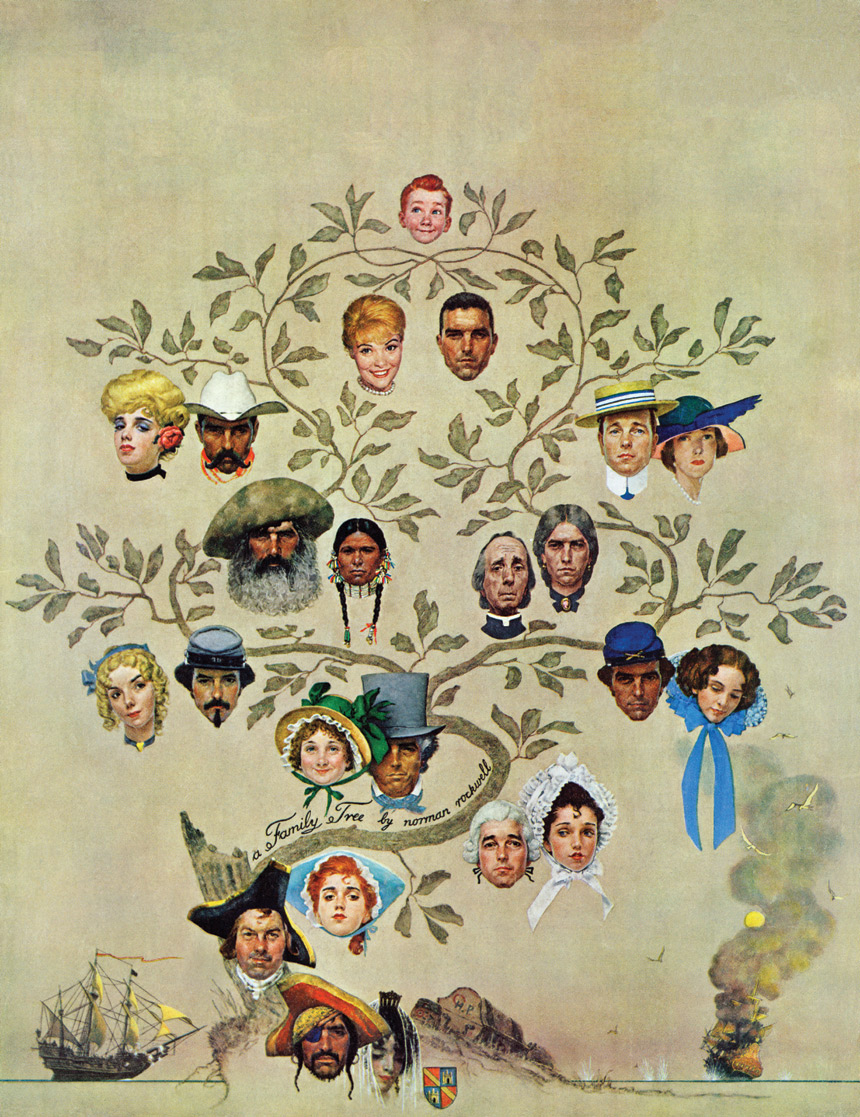
Norman Rockwell
October 25, 1959
This article is featured in the January/February 2019 issue of The Saturday Evening Post. Subscribe to the magazine for more art, inspiring stories, fiction, humor, and features from our archives.
Cover Collection: Norman Rockwell’s Charles Dickens Series
It was customary for George Horace Lorimer, the legendary Post editor who oversaw the publication from 1899 to 1936, to choose only three sketches or paintings at a time for a cover. But that changed in 1920, when Norman Rockwell met with Lorimer and displayed a multitude of holiday sketches—not just for the coming year but for the entire decade.
It was a risky move, but Rockwell had an ace up his sleeve. The subject matter centered on a common theme, the stories of Charles Dickens, and Rockwell happened to know his boss was
a huge Dickens fan. Lorimer gave the entire series a green light.
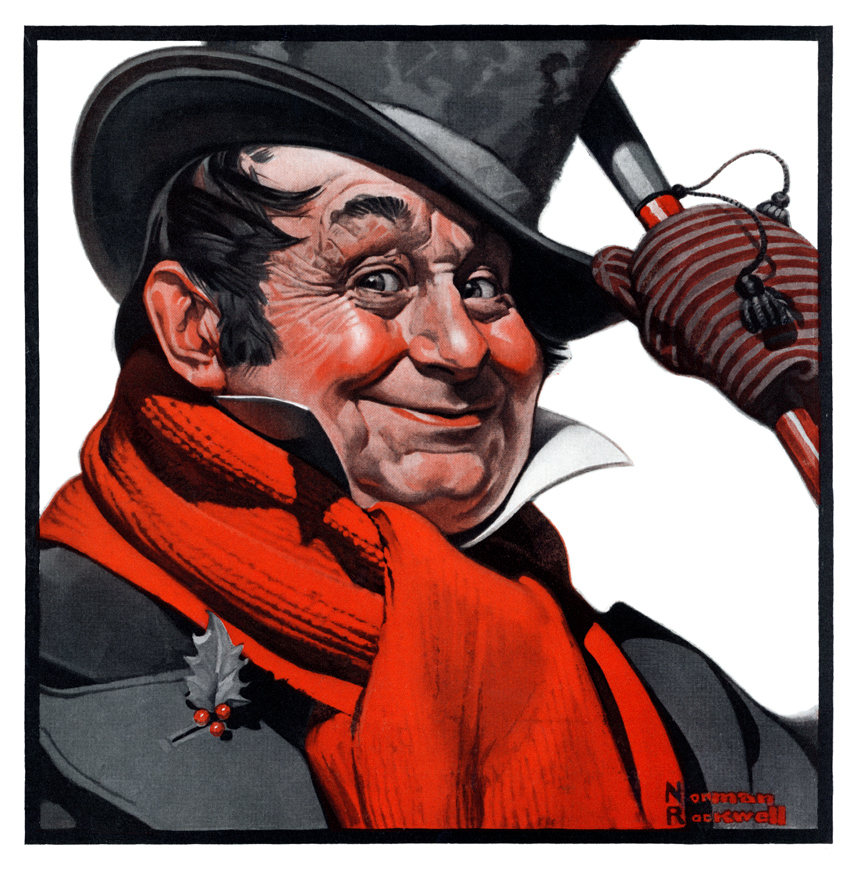
December 3, 1921
The first picture for his Dickens series was this illustration of a jocular man wearing a 19th-century hat and holding a cane. When the work was done, the artist confessed to Lorimer that he had dedicated the painting to him. Touched by the gesture, but not one to display sentimentality, Lorimer thanked the young artist with a handshake.
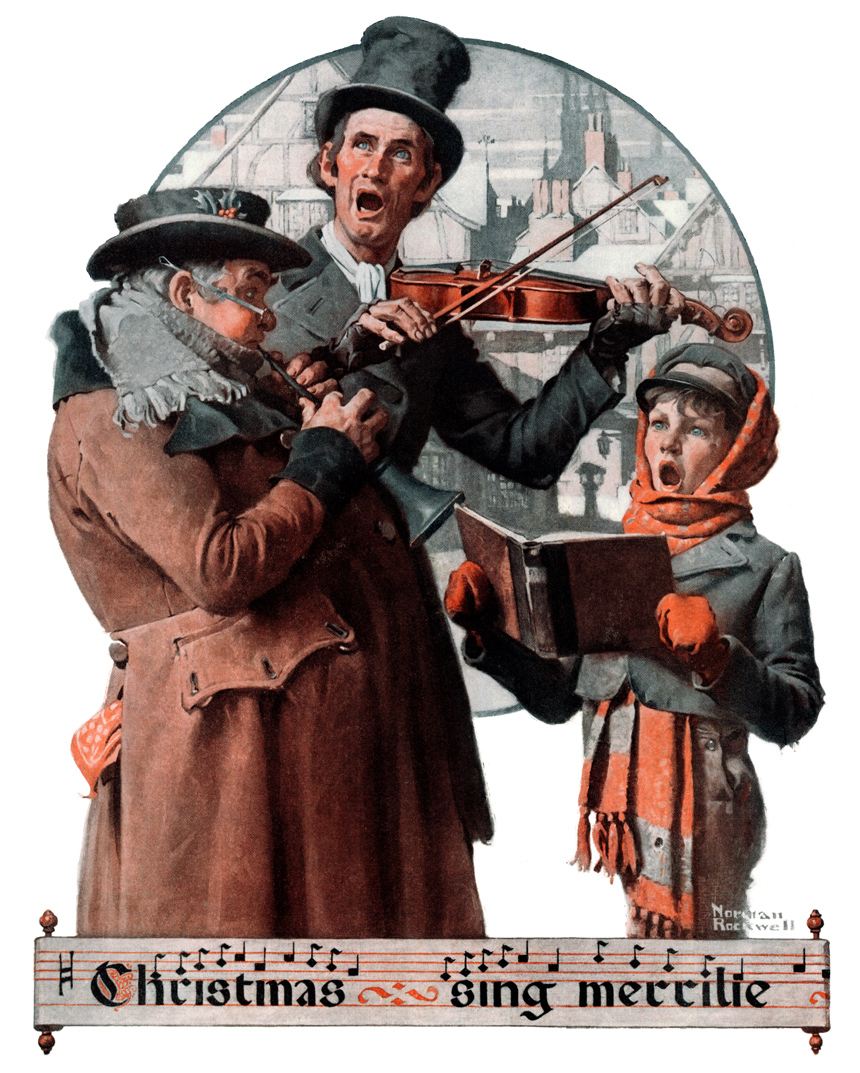
December 8, 1923
Dickens’ portrayal of Victorian society in London captivated Rockwell. He especially admired the street-corner musicians, talented ragamuffins who depended on the kindness of strangers. Rockwell selected his three models for their outward appearance and not their musical talent. Neither “Pop” Fredericks, Dave Campion , nor Bill Sundermeyer could sing or play a lick!
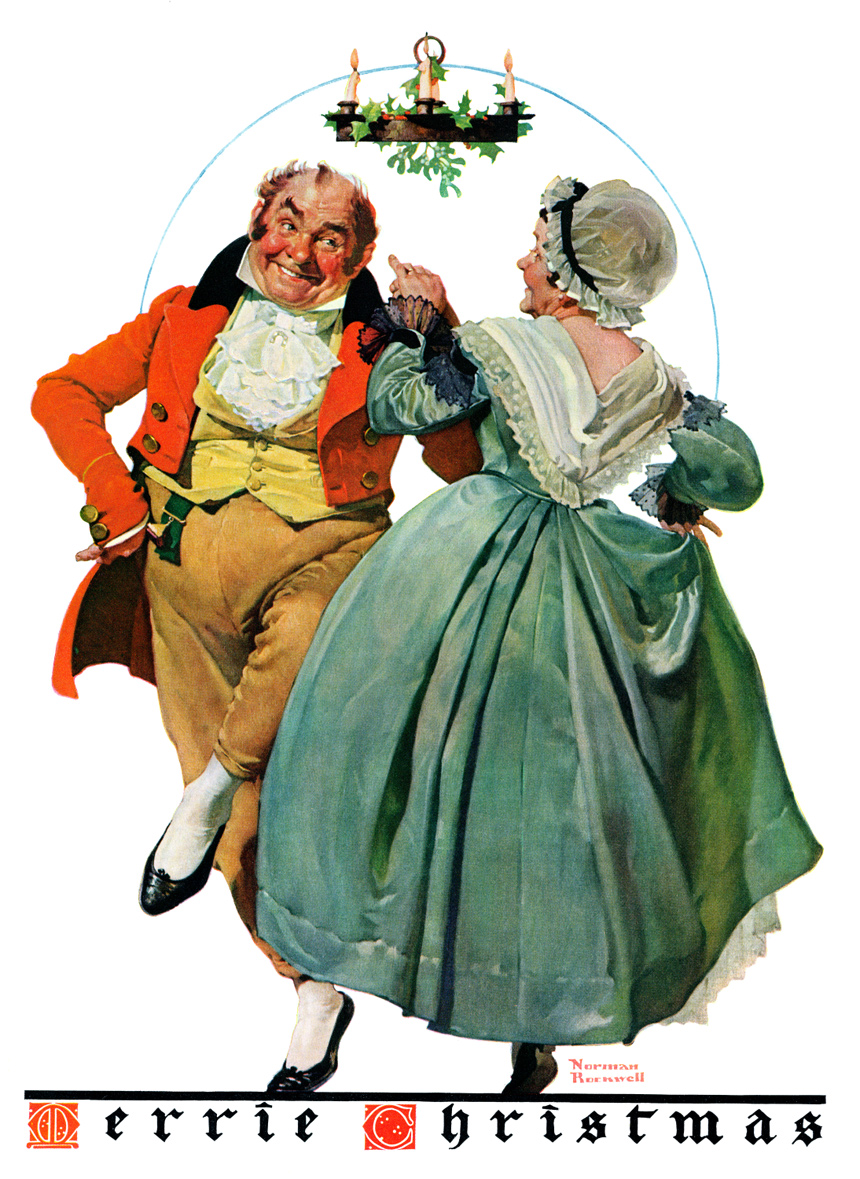
December 8, 1928
The cover’s inspiration comes from the scene in A Christmas Carol in which old Mr. Fezziwig, the benevolent master of young Ebenezer Scrooge, shows his guests how to dance: “Then old Fezziwig stood out to dance with Mrs. Fezziwig. … A positive light appeared to issue from Fezziwig’s calves. They shone in every part of the dance like moons. You couldn’t have predicted, at any given time, what would have become of ’em next. And when old Fezziwig and Mrs. Fezziwig had gone all through the dance; advance and retire, both hands to your partner, bow and curtsey, corkscrew, thread-the-needle, and back again to your place; Fezziwig ‘cut’—cut so deftly, that he appeared to wink with his legs, and came upon his feet again without a stagger.”
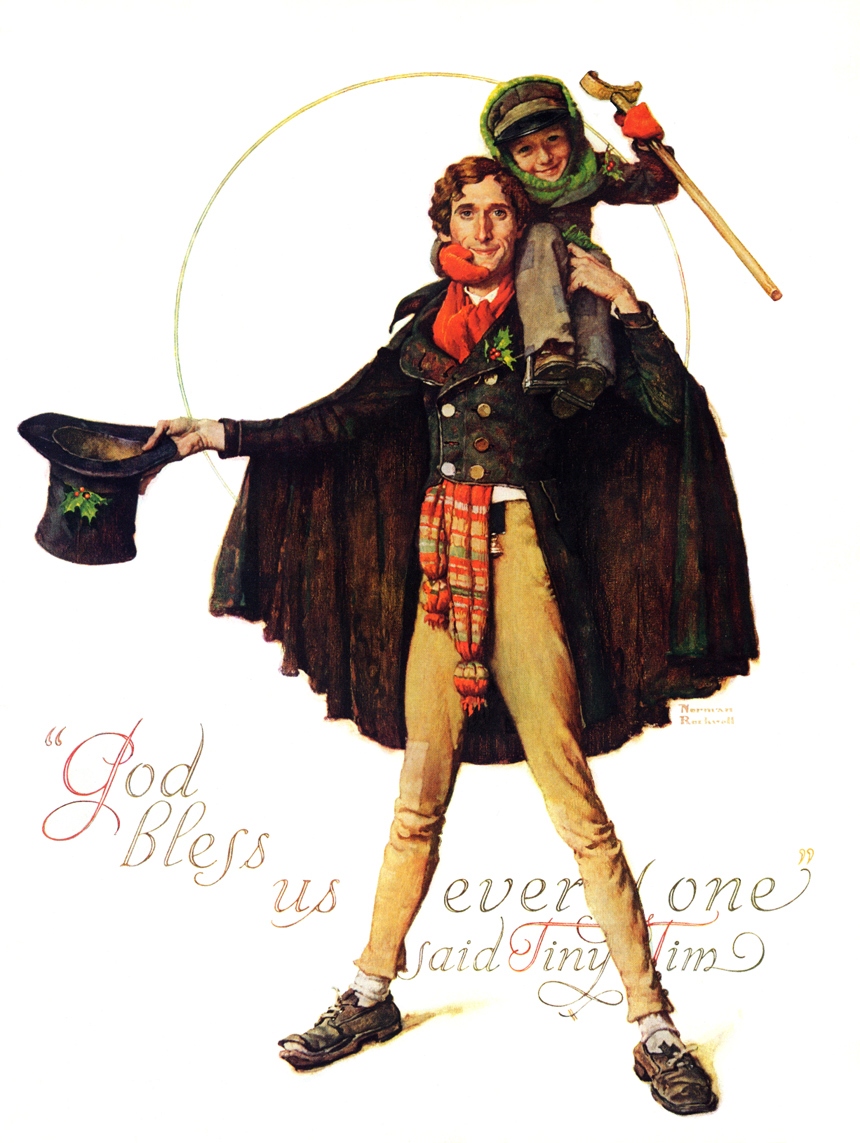
December 15, 1934
Competitors of The Saturday Evening Post had a name for the uncanny timing of its covers—“Post luck!” But was it luck? Lorimer, a master of networking and incredibly in tune with trends of the day, knew the movie A Christmas Carol was set to be released on December 16, 1934, one day after this cover would appear on newsstands. The movie’s release date was no great secret, but Lorimer did his homework early and actually contacted Rockwell to propose this cover 11 months before the publication date. At the time, he had inside information that an as-yet-unpublished survey had determined A Christmas Carol to be America’s all-time favorite Dickens story. Moral of the story: Sometimes you make your own luck!
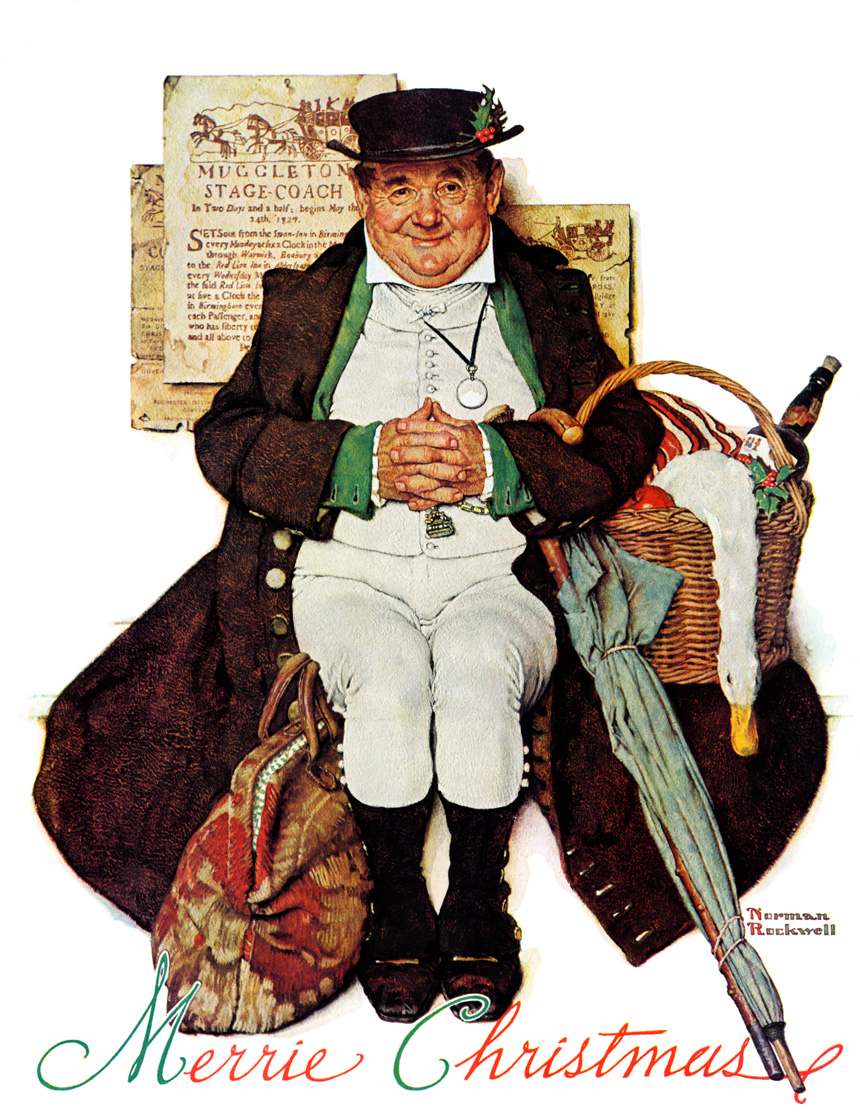
December 17, 1938
In this third “Merrie Christmas” cover, Pickwick sits patiently waiting for the Muggleton Stagecoach wearing his flannel jacket and white trousers. Unlike earlier paintings from Rockwell’s Dickens series, this one adheres quite precisely to a scene from the original story. Lorimer had recently retired, and the new Post editor issued a directive to Rockwell: He was to represent Dickens’ stories literally; creative interpretation of a writer’s work would not be permitted. Rockwell was not particularly happy about this limitation. But his friend and longtime model Harry Seals (depicted here as Pickwick) suggested that the artist just smile and let his new boss’s words go in one ear and out the other. Seals’ ironic smile seems to convey this very lesson. A footnote: Six months after posing for this painting, and three months after it was published on the cover of The Saturday Evening Post, Seals died. This December 17, 1938, issue was resting on an easel at his funeral.
Rockwell Video Minute: Discovering Santa Claus
After painting 27 Christmas covers for the Post, Norman Rockwell had become closely associated with the traditions images of the holiday, but he was about to upend all that with his illustration, The Discovery.
See all of the videos in our Rockwell Video Minute series at saturdayeveningpost.com/category/rockwell-video-minute/.
Rockwell Paints an Unexpected Christmas Discovery
For Christmas of 1956, Rockwell captured a moment of truth in a young boy’s life. While snooping in his parent’s bedroom, he comes across a familiar suit and puts two and two together. The result is an expression of shock and disillusionment that Rockwell made so vivid, you can feel it rising from the page.
But Rockwell wasn’t content to present just a comic scene. He filled the frame with details to build atmosphere and reward close attention.
Note how he captured the wood grain of the dresser — the nicks, dings, and stains that make a piece of furniture almost a member of the family. Then there’s the twine that secured the box with Dad’s suit and beard and the mothballs that have rolled across the carpet. Rockwell even went to the effort of including the open door through which junior snuck in, the stair rails beyond, even a glimpse of the house next door — details only a dedicated artist would include.
Rockwell’s model, Scott Ingram, became a minor celebrity for his expression of wide-eyed surprise. Being the figure on a Rockwell cover, he said, changed his life. He received fan mail, and was asked to autograph pictures and books. He even appeared on TV with Rockwell on the Hallmark Hall of Fame. He fondly remembered the milkshakes he received at the end of each session.
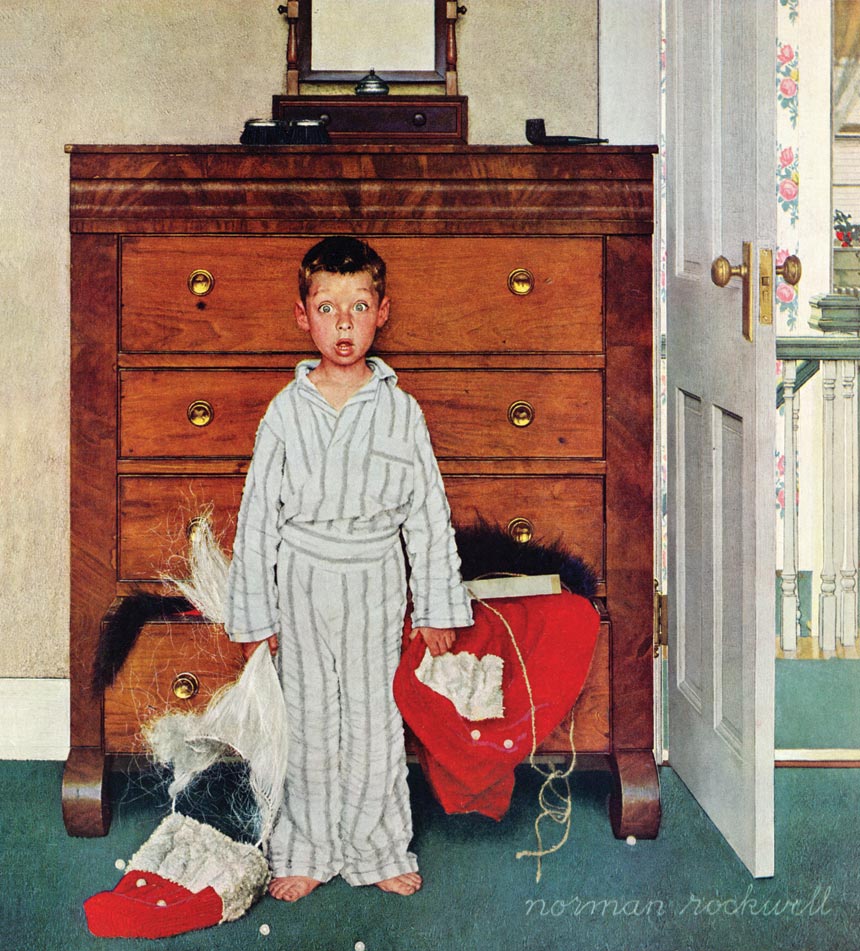
Rockwell Video Minute: Before the Shot
Which way the doctor should be facing, what kind of chairs to use, and what the floor should look like were all details that Norman Rockwell pondered. But none of these issues compared to the biggest dilemma he faced when it came to composing this painting.
See all of the videos in our Rockwell Video Minute series at www.saturdayeveningpost/rockwell-video.
Cartoons: It’s a Ruff Life
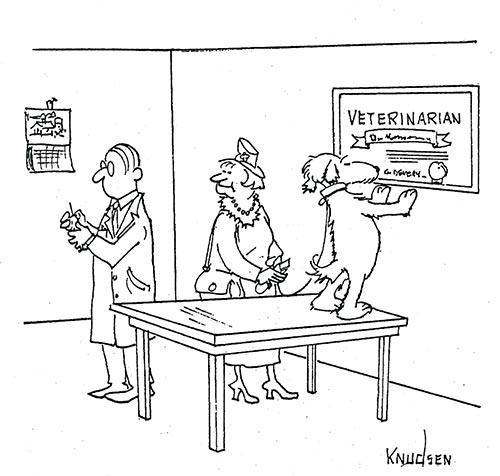

January/February 1998


December 1982

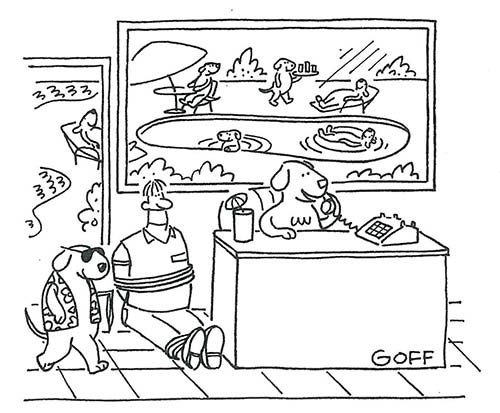
July/August 1993
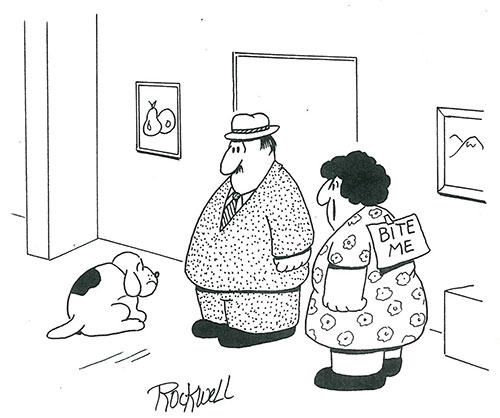
November/December 1993
Rockwell Video Minute: A World War II Veteran’s Imperfect Fit
Norman Rockwell used a returning World War II veteran as his model so he could capture the true look and spirit of an American soldier.
See all of the videos in our Rockwell Video Minute series.
Rockwell Video Minute: Soda Jerk
Norman Rockwell’s “Soda Jerk” is one of his most well-known paintings, and one of many that features his family. In this case, it’s his youngest son, Peter, who worked at a soda fountain in real like (and is where Rockwell got the idea).
See all of the videos in our Rockwell Video Minute series at www.saturdayeveningpost/rockwell-video.
The Rockwell Files: Best Job Ever
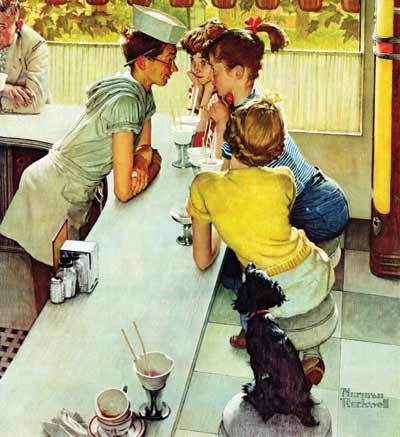
Rockwell’s inspiration for this August 22, 1953, cover illustration grew out of stories his son Peter told of working a soda counter one summer. Peter even posed as the young man when Dad painted the scene. When his father showed him the final product, Peter didn’t like it. He claimed he “wasn’t that goofy looking.”
In an earlier draft of the illustration, the counter was more crowded. A gentleman’s balding head was visible in the foreground, and a mother and son sat at the far end of the counter. But Rockwell removed them so he could draw viewers’ attention to the mid-canvas drama, where a boy and three girls stare at each other across a counter with rapt attention.
As always, Rockwell adds numerous masterful details, like the reflection of the sugar dispenser in the napkin holder, the grated floor that would prevent slipping on spills, and the vintage Wurlitzer jukebox just visible at the right edge. And that man in the corner? We can pretty easily guess what he’s thinking: Hot fudge! Ice cream! Girls! Why weren’t there summer jobs like this when I was young?
This article is featured in the July/August 2018 issue of The Saturday Evening Post. Subscribe to the magazine for more art, inspiring stories, fiction, humor, and features from our archives.
Rockwell Video Minute: New TV Set
When Americans were first getting TV sets in their homes, Norman Rockwell was there to capture the moment perfectly.
See all of the videos in our Rockwell Video Minute series at www.saturdayeveningpost/rockwell-video.
The Rockwell Files: Pain in the Rear
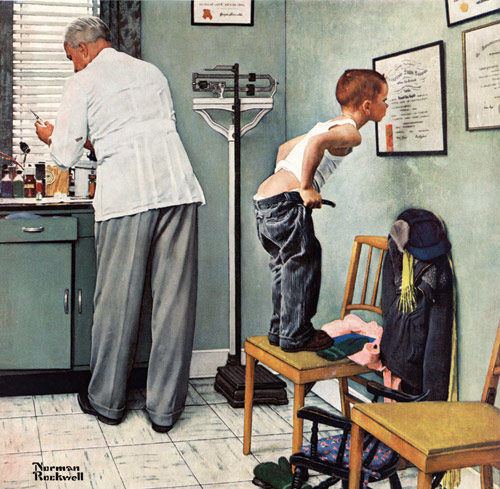
When Norman Rockwell was planning this iconic Post cover, he spent a certain amount of time considering how much of the boy’s derriere to show.
Too much cheek would be considered rude, and too little wouldn’t be funny. He discussed it with friends and family and finally settled for this half-up, half-down compromise.
Later that same year, the same young model, Eddie Locke, would pose alongside a state policeman for Rockwell’s Runaway cover.
As an adult, Eddie was asked what his boyhood friends thought of his modeling for the Post.
“You know,” he replied, “when you’re sitting with a police officer, that’s one thing. When you’re posing with your pants down, that’s quite another.”
Rockwell Video Minute: Walking to Church
Norman Rockwell was often inspired by the great masters: in fact, one of his paintings was a tribute to the Dutch painter of the 17th century, Johannes Vermeer.
See all of the videos in our Rockwell Video Minute series at www.saturdayeveningpost/rockwell-video.
News of the Week: Killer Bees, Four Freedoms, and People Try to Name a Book (Any Book at All)
The Sting of Spring
Mother Nature and assorted meteorologists have been toying with us this spring, throwing in 49-degree days along with the 70-degree ones. But we’ve turned a corner. The warm weather is here. There’s no turning back now.
I killed a giant bee in my apartment recently. The first appearance of an insect in the spring is always a bit disorienting. I heard the buzzing sound, but it was so loud I thought it was coming from construction equipment down the street. Then I saw it fly by my television and flap around the window. At first I didn’t know what to attack it with. A shoe would have been cumbersome in the window, and I didn’t want to use my copy of The Saturday Evening Post. So I used the next most logical thing: the 1951 Loretta Young film noir Cause for Alarm! Hey, I panicked and didn’t want the bee to get away! For some reason I own two copies of it and decided to sacrifice one to squash the bee (in my defense, it is considered a B-movie).
I’m usually a curmudgeon when it comes to warm weather. I start complaining about the temperatures on Memorial Day and I don’t stop until after Labor Day. But this year, I’ve decided to embrace it. I’ll wear shorts and drink cold drinks and watch tennis until the better weather comes along. If you can’t beat ’em, join ’em. Just make sure you have plenty of extra DVDs on hand to kill the bugs.
Want, Worship, Speech, Fear
Starting today, the New York Historical Society will host an exhibition of Norman Rockwell’s Four Freedoms paintings, in a celebration of Rockwell, Franklin D. Roosevelt, and America. The “Rockwell, Roosevelt & the Four Freedoms” exhibition will last until September 2 and will then go on tour to several other locations around the world, including The Henry Ford in Dearborn, Michigan, The Textile Museum in Washington, D.C., the Mémorial de Caen in Normandy, France, and the Norman Rockwell Museum in Stockbridge, Massachusetts.
To celebrate the tour, Turner Classic Movies had a marathon of movies inspired by Four Freedoms this week, hosted by Ben Mankiewicz. It included an interview with Harvey J. Kaye, author of The Fight for the Four Freedoms: What Made FDR and the Greatest Generation Truly Great. The films Mankiewicz and Kaye discussed included The Grapes of Wrath, Casablanca, Deadline U.S.A., and two short films from 1945: The Cummington Story and The House I Live In, with Frank Sinatra.
Guitar Hero
A guitar that Bob Dylan played on his first electric tour — and later strummed by Robbie Robertson — sold at auction this week for $490,000.
It should be noted, however, that this isn’t the guitar Dylan played at the 1965 Newport Folk Festival, the one that caused an uproar because some fans just couldn’t believe he had gone electric. That concert is one of the many topics in this 1968 Post profile of Dylan by Alfred Aronowitz.
Shirley
I love going through the Post archives to see who wrote for the magazine over the years. It’s an impressive list, and it includes Shirley Jackson, probably best known for her short story that’s taught in every high school English class, “The Lottery.” In the March 27, 1965, issue we published Jackson’s short story “The Bus.” She died just five months later.
This week it was announced that the Mad Men and Handmaid’s Tale star Elisabeth Moss will play Jackson in a new movie based on Susan Scarf Merrell’s novel Shirley. It’s about a couple who move in with Jackson and her husband and wish they hadn’t.
Can You Name a Book?
Speaking of books, can you name one? If someone stopped you on the street and asked you to name a book — any book at all — could you do it? Of course you could! But these people interviewed on Jimmy Kimmel Live! had a lot more trouble.
RIP Philip Roth, Joseph Campanella, Clint Walker, Richard Goodwin, Robert Indiana, Jimmy Nickerson, and Patricia Morison
Philip Roth was one of the great writers of the 20th century, known for such novels as American Pastoral, Portnoy’s Complaint, Goodbye, Columbus, and many others. He died Tuesday at the age of 85.
Here’s a funny remembrance of meeting Roth from Billions creator Brian Koppelman.
Joseph Campanella was a veteran actor who appeared in dozens of TV shows and movies. He died last week at the age of 92.
Clint Walker starred in the popular western series Cheyenne from 1955 to 1962 and appeared in many other shows and movies. He died Monday at the age of 90.
Richard Goodwin was a speechwriter and adviser to Presidents John F. Kennedy and Lyndon Johnson. He also wrote several books and was married to historian and author Doris Kearns Goodwin. He was a member of the House subcommittee that investigated rigged game shows in the late ’50s and was portrayed by Rob Morrow in the 1994 movie Quiz Show. He died Sunday at the age of 86.
Robert Indiana was an artist probably best known for his “LOVE” series of images in the 1960s. He died Saturday at the age of 89.
Jimmy Nickerson was a stuntman and actor who appeared in tons of classic movies and TV shows. He died earlier this month at the age of 68.
Patricia Morison was the original star of the Cole Porter musical Kiss Me, Kate in 1948 and went on to appear in many other stage productions and movies, including The Song of Bernadette, Song of the Thin Man, and the last Basil Rathbone Sherlock Holmes film, Dressed to Kill. She even appeared in an episode of Cheers. Morison died Sunday at the age of 103.
Quote of the Week
Not really a quote, it’s a headline, but it’s important news:
This Hawaii volcano sounds incredible. Via https://t.co/fVUSBNywwF pic.twitter.com/vxAQiRZNHx
— Tom Chivers (@TomChivers) May 18, 2018
This Week in History
Charles Lindbergh Takes Off (May 20, 1927)
Two months after the aviator made the first solo flight across the Atlantic, the Post honored Lindbergh with this Norman Rockwell cover.
Johnny Carson’s Last Tonight Show (May 22, 1992)
Carson was host of the NBC late night show for 30 years. Jay Leno took over the following Monday and didn’t thank Carson at all, a decision he called the biggest mistake of his career.
This Week in Saturday Evening Post History: First Norman Rockwell Cover (May 20, 1916)
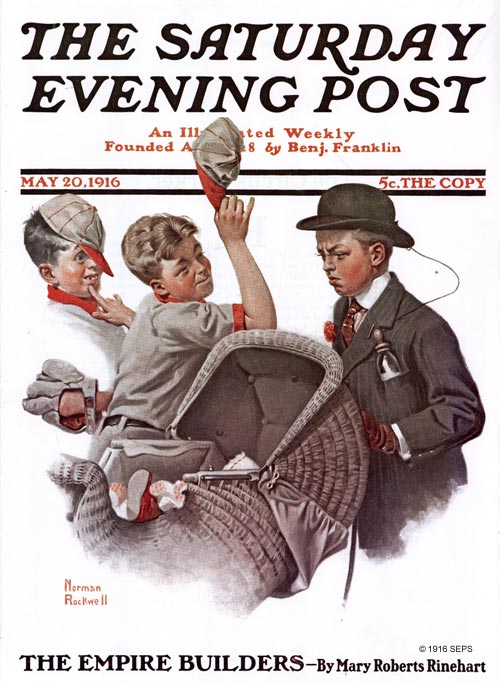
By: Norman Rockwell
May 20, 1916
Rockwell’s first cover was titled Boy with Baby Carriage. He also did the first full-color cover for the Post, The Old Sign Painter, in 1926.
French Food

The French Open tennis tournament starts Monday. There’s a big controversy this year because Serena Williams won’t be seeded due to the time she took off to have a baby. She was ranked number one when she left the tour and now she’s ranked 453, which means she’ll have to play the top players earlier. I think the moral to this story is “kids ruin everything.”
But let’s talk about French food. Here’s a classic recipe for Coq Au Vin from Bon Appétit and one for French Onion Soup Au Gratin. And because you can never have enough recipes with “au” in the name, here’s a recipe for Potatoes Au Gratin.
You can eat while watching the French Open coverage on NBC and the Tennis Channel, even if you will have to do it in the morning because of the time zone difference. But maybe it’s time Coq Au Vin became a breakfast staple.
Next Week’s Holidays and Events
Memorial Day (May 28)
Here’s Pamela Krol on what the day means and why it’s important to always remember.
Scripps National Spelling Bee (May 29)
You can watch all the preliminaries on ESPN3 starting at 9:15 a.m. and then the finals May 31 on ESPN2 starting at 10 a.m.
Last year’s winning word was marocain, which is a word I’ll probably never use, but it is an anagram of macaroni.
Rockwell Video Minute: Rosie the Riveter
Norman Rockwell honored the contributions of the millions of women working in defense plants during World War II with his iconic painting of Rosie the Riveter.
See all of the videos in our Rockwell Video Minute series at www.saturdayeveningpost/rockwell-video.